In Vitro Differentiation of Human iPS Cells into Airway Epithelial Lung Organoids for Respiratory Disease Research Applications
Min Lu, Kevin Su, Nick Asbrock, Vi Chu
Lung organoids are useful three-dimensional (3D) cell culture models for studying human lung development and respiratory diseases including viral infections (SARS-CoV, H1N1, MERS), cystic fibrosis, asthma/COPD, exposure to air pollution and the effects of smoking. Unlike traditional immortalized pulmonary cell lines and primary cells, lung organoids contain various differentiated cell types with complex tissue architecture that more closely resemble in vivo tissues and functionality. Additionally, lung organoids can be derived from small amounts of patient tissues or pluripotent stem cells to create living biobanks that facilitate personalized biomedical research.
The 3dGRO™ Human Lung Organoid Culture System is a serum-free, multi-stage culture system for efficient differentiation of human induced pluripotent stem (iPS) cells to mature lung organoids that structurally resemble the in vivo branching airway and early alveolar structures. Using the 3dGRO™ Human Lung Organoid Culture System, large numbers of mature lung organoids may be generated that express appropriate markers indicative of multiple cell types found in the mature lung and airways including SFTPB and SFTPC (surfactant protein B and surfactant protein C) found in type II alveolar epithelial (ATII) cells, MUC5AC (airway goblet cells), EpCAM, Sox9 and Nkx2.1 (pulmonary endoderm), Acetyl-α-Tubulin (ciliated cells) and the mesenchymal marker vimentin. Additionally, lung organoids also express angiotensin-converting enzyme 2 (ACE2), the receptor for the novel SARS-CoV-2 virus that causes COVID-19, along with TMPRSS2, the serine protease that enhances SARS-CoV-2 viral entry.

Figure 1. Human lung organoid differentiation workflow. Human pluripotent stem cells are differentiated into definitive endoderm cells using a 4-day induction medium. During days 4-8, induction media (SCM305, SCM306) directs human definitive endoderm cells toward anterior foregut endoderm (AFE). AFE cells may be cryopreserved (SCC301) or further differentiated into branching lung bud organoids using 3dGRO™ Lung Organoid Branching Medium (SCM307) and further matured into branching and alveolar lung organoids using 3dGRO™ Lung Organoid Maturation Medium (SCM308).
Lung Organoid Differentiation Protocol
Step 1: Differentiation of Human iPS Cells into Definitive Endoderm (Day 0-4)
Note: Start with high-quality undifferentiated human ES/iPS cells (SCC271) that are ~70-80% confluent and contain <5% differentiated cells. The following protocol is for differentiation of one well of a six-well tissue culture-treated plate. Indicated volumes are for a single well. Adjust volumes as necessary.
- Prepare single-cell passaging media. Add ROCK inhibitor (ROCKi) Y-27632 (SCM075) to 7-10 mL Human ES/iPS cell Expansion Media (SCM130) to a final concentration of 10 µM.
- Coat a 6-well plate with ECM Gel (CC131).
- Aspirate the medium. Wash the well with 2 mL of DMEM/F12 or 1X PBS. Aspirate and add 1 mL of Accumax™ solution (A7089) to the well. Incubate for 5-6 minutes at 37̣ °C. Tap the plate firmly against the palm of your hand to help dislodge the cells.
- Add 1 mL of the single-cell passaging media (from step 1) to the well. Pipette up and down 1-3 times with a 5 mL pipettor to dislodge the cells. Be careful to not introduce any bubbles.
- Collect the dissociated cells in a 15 mL conical tube. Add 1 mL of single-cell passaging media to the well and collect any remaining cells for transfer to the 15 mL conical tube containing the cell suspension. Centrifuge the tube at 140 x g for 5 minutes and aspirate the supernatant.
- Resuspend the cell pellet in 1 mL of single-cell passaging media. Count the total number of live cells using an automated cell counter or Trypan blue (T8154) and a hemocytometer.
- Add 1x106 cells per well to an ECM Gel (CC131) -coated 6-well plate. The media used should be the single-cell passaging media (from step 1). Total volume = 3 mL per well. Incubate at 37 °C overnight.
- Aspirate the media from the well. Add 2 mL of Definitive Endoderm Induction Medium (SCM302) to the well and incubate at 37 °C overnight.
- Repeat step 8 for day 2 and day 3. Analyze cells by flow cytometry on day 4. Before proceeding to step 2, cells should be >80% positive for the endoderm markers CXCR4, c-Kit, Sox-17, and FOXA2, and negative for PDGFR.
Step 2: Differentiation of DE Cells into Anterior Foregut Endoderm Cells (Day 4-8)
Note: High cell density should be observed at both day 4 of definitive endoderm cells and also at day 8 after differentiation to anterior foregut endoderm (AFE) cells. The protocol below provides a reference seeding density in a 6-well plate format. Adjust the seeding density for other plate formats.
- Remove the 6-well plate containing day 4 definitive endoderm cultures from the incubator.
- Aspirate the medium from each well. Wash each well with 2 mL 1X PBS (BSS-1006-B).
- Add 1 mL of Accumax™ solution (A7089) per well to dissociate definitive endoderm cells. Incubate at 37 °C for 6-8 minutes.
- After 5 minutes, visually inspect the plate. Gently tap the edge of the plate to further detach the cells. Most of the cells should detach as a suspension. If not, incubate 2 minutes more.
- Add 2 mL per well of 1X PBS (BSS-1006-B) to dilute the AccuMax™ solution (A7089). Pool the cell suspension into 50 mL conical tube(s). Rinse each well with 1 mL 1X PBS to collect any remaining cells and add to the 50 mL conical tube. Pipette up and down several times to achieve a single cell suspension.
- Centrifuge the cell suspension at 130 x g for 5 minutes at room temperature.
- Aspirate the supernatant. Resuspend the cell pellet in 2 mL of AFE Induction Medium I (SCM305). Count the cells using an automated cell counter or hemocytometer.
Coat 6-well plates with fibronectin (F0895) at 4 µg/mL in PBS. Add 1.5 mL of diluted fibronectin per well. Store coated dishes overnight at 2-8 °C. Aspirate the coating solution. Air dry in the hood with the lid off for 5 minutes. When the plates are dried, cover the plate with the lid and set aside until cells are ready. - Plate 1X106 cells per well onto fibronectin-coated 6-well plates. Add the appropriate volume of AFE Induction Medium I (SCM305) to each well to obtain a total volume of 2 mL per well.
- Place the plate in a 37 °C incubator. Agitate the plate gently from side to side and forward and backward to ensure that the cells are evenly distributed across the surface of the well. Incubate at 37 °C overnight.
- Day 5: Replace with 2 mL per well of AFE Induction Medium II (SCM306). Incubate at 37 °C for 24 hours.
- Day 6: Replace medium with 2 mL per well of 3dGRO™ Lung Organoid Branching Medium (SCM307). Incubate at 37 °C for 24 hours.
- Day 7: Replace medium with 2 mL per well of 3dGRO™ Lung Organoid Branching Medium (SCM307). Incubate at 37 °C for 24 hours.
- Day 8: AFE cells should exhibit morphological changes comprised of confluent areas interspersed with cell clusters/aggregates. Follow the protocol to further differentiate into mature lung organoids. Surplus AFE cells can be cryopreserved using 3dGRO™ Organoid Freeze Medium (SCM301) at 3-6 x 106 cells per vial.
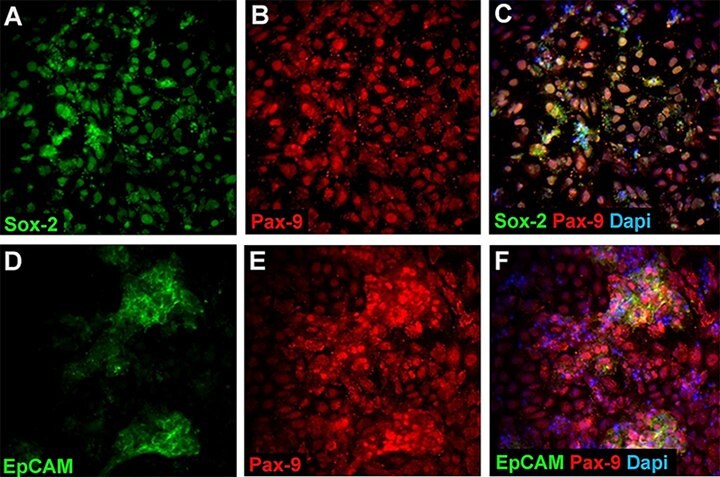
Figure 2. Anterior foregut endoderm (AFE) marker expression. Approximately 95-100% of AFE cells are double positive for Sox2 (A, C, AB5603A4) and Pax9 (B, C). Approximately 20-30% of AFE cells are double positive for EpCAM (D, F, MAB4444) and Pax9 (E, F).
Step 3: Differentiation of AFE Cells into Lung Bud Organoids (Day 8-25)
- Aspirate and add 1 mL fresh 3dGRO™ Lung Organoid Branching Medium (SCM307) to each well of the 6-well plate containing the confluent layer of AFE cells.
- Using a 5 mL pipette, gently scrape along the surface of each well to dislodge the cell monolayer as aggregates. Be careful to not triturate into single cells. Transfer the cell aggregates from 1 well of a 6-well plate to a well of a Costar® Ultra-Low Attachment 24-well plate (CLS3473).
- Add 0.5 mL of 3dGRO™ Lung Organoid Branching Medium (SCM307) to collect any remaining cells and add to the well of cells in the low attachment 24-well plate. Total volume = ~ 1.5 mL cell suspension. Incubate at 37 °C.
- Exchange the media every other day until days 20-25. As the organoids are in floating culture, use the following protocol for the media exchanges:
- Use a 1 mL glass serological pipette to transfer the floating organoids to a sterile 15 mL conical tube. Wait 10 minutes for the organoids to settle to the bottom of the tube.
- Attach a 2 mL aspirating pipette to the vacuum pump. To the 2 mL aspirating pipette, attach a sterile, 20 µL non-barrier pipette tip. Carefully aspirate the medium. Be careful to leave a small volume of medium above the organoids as a buffer to avoid disturbing the organoids.
- Add 0.5 mL 3dGRO™ Lung Organoid Branching Medium (SCM307) to the 15 mL tube containing the organoid pellet. Pipette up and down twice with a 1 mL glass pipette. Transfer the organoids back to the same well in the ultra-low attachment 24 well plate.
- Add 0.5 mL 3dGRO™ Lung Organoid Branching Medium (SCM307) to the 15 mL conical tube to rinse and collect any remaining organoids. Add the rinse to the same well of the ultra-low attachment 24-well plate. Total volume = 1 mL per well.
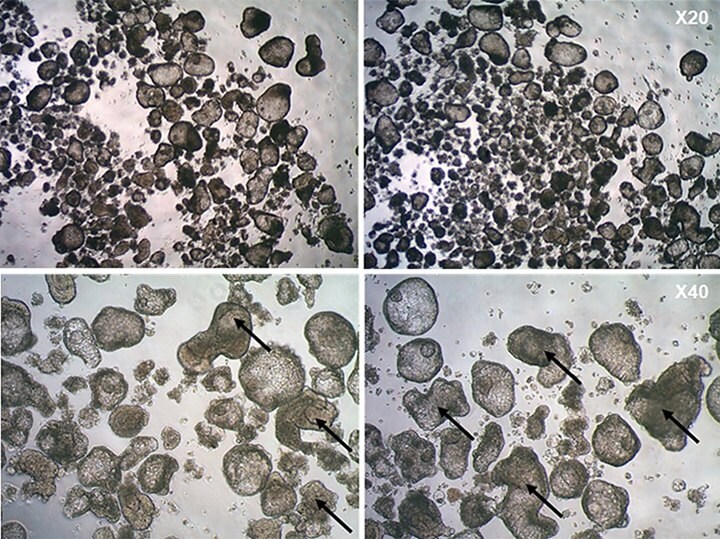
Figure 3. Human lung bud organoids (LBOs) in suspension cultures. Morphology of immature human iPS cell-derived LBOs on day 23 of differentiation. The lower panels show optimal organoids with folded structures (arrows) that may be selected for further maturation in Matrigel® sandwiches using 3dGRO™ Lung Organoid Maturation Medium (step 4).
Step 4: Differentiation of Lung Bud Organoids (LBOs) into Mature Lung Organoids (Day 25-60)
- Thaw Growth Factor Reduced Matrigel® matrix (Corning Cat. No. 354230) on ice.
- Use sterile forceps to transfer sterile 24-well inserts (Corning Cat. No. 353095) into non-tissue culture-treated 24-well plate (Corning Cat. No. 351147), using one insert per well.
- Aliquot 50 µL of cold 100% Growth Factor Reduced Matrigel® matrix to each insert. Wait 5 minutes for the Matrigel® matrix to solidify.
- Meanwhile, transfer one well of floating lung bud organoids (LBOs) to a 60 mm Petri dish. In a separate 96-well U-bottom plate, add 60 µL of 3dGRO™ Lung Organoid Maturation Medium (SCM308) to each well.
Note: By days 20-25, there will be many floating lung organoids (Figure 3). Each Matrigel® sandwich should contain approximately 4-6 organoids. Calculate the number of Matrigel® sandwiches you plan to make to determine the total number of wells in the 96-well plate that you will need to prepare the organoid/Matrigel® suspension. - In a sterile dissection hood, use a sterile 20 µL pipette tip set at 10 µL volume to select and transfer 6 folded organoids from the 60 mm culture dish to 1 well of the 96-well U-bottom plate.
- Transfer the 96-well plate from the dissection hood to the tissue culture hood.
Note: To avoid premature gelling of the Matrigel® matrix, we recommend preparing no more than 3 inserts at a time.- Add 60 µL of cold 100% Growth Factor Reduced (GFR) Matrigel® matrix into each well of the 96-well plate from step 5. Mix gently by pipetting several times and avoid generating any bubbles. Total volume = 130 µL per well.
- Immediately transfer the organoid-GFR Matrigel® matrix mixture (~130 µL) to the center of each insert in the 24-well plate prepared in step 3.
- Wait 5 minutes for the Matrigel® matrix to solidify.
- Repeat until a total of 6 sandwiches are processed.
- Add 75 µL of cold 100% Growth Factor Reduced (GFR) Matrigel® matrix to the top of the inserts to create the Matrigel® sandwich. Put the 24-well plates in an incubator at 37 °C for at least 30 minutes to ensure the Matrigel® sandwiches have solidified. If you have more than 6 sandwiches to embed, repeat Steps 4-7.
- Add 500 µL of 3dGRO™ Lung Organoid Maturation Medium (SCM308) on top of each insert, and 500 µL into the wells underneath the inserts.
- Exchange the medium every other day.
- Attach a 2 mL aspirating pipette to the vacuum pump. To the 2 mL aspirating pipette, attach a sterile, 20 µL non-barrier pipette tip. Carefully aspirate the medium on top of the Matrigel® sandwiches and also underneath the inserts.
- Add 500 µL of 3dGRO™ Lung Organoid Maturation Medium (SCM308) on top of each insert and 500 µL into the wells underneath the inserts.
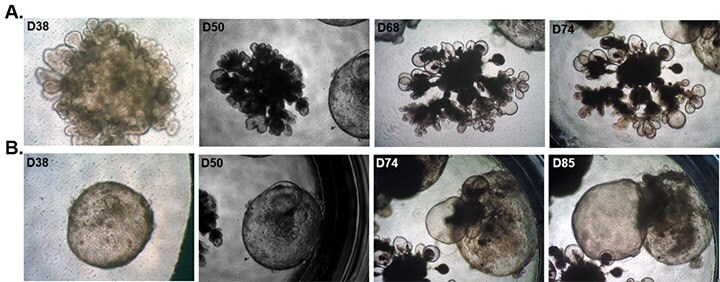
Figure 4. Time course for lung organoid maturation. Tracking human iPS cell-derived lung organoid differentiation in two individual wells. At day 20-25, around 4-6 immature LBOs were embedded in a Matrigel® matrix using 3dGRO™ Lung Organoid Maturation Medium. Various morphologies were observed which included branching structures and/or rounded expansion at the tips with dense materials in the center resembling alveolospheres. When the culture is maintained beyond day 60-70, some large rounded structures may rupture, releasing a mucus-like material.
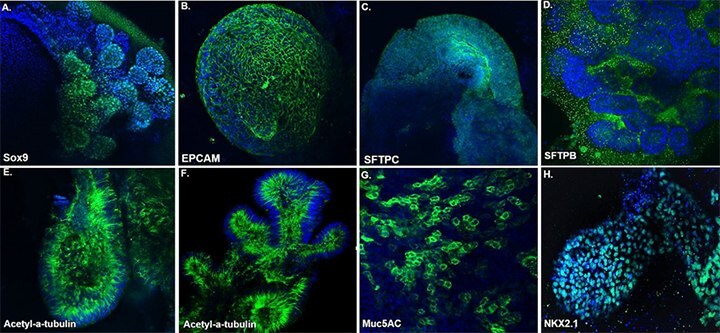
Figure 5. Lung organoid marker expression. Day 70 mature lung organoids derived from human peripheral blood mononuclear cells (PBMCs) and HFF human iPS cells express markers of surfactant-producing type II alveolar epithelial cells (SFTPC and SFTPB), airway goblet cells (Muc5AC), pulmonary endoderm (EPCAM, Sox9, NKX2.1) and ciliated cells (Acetyl-α-Tubulin). Nuclei are counterstained with DAPI.
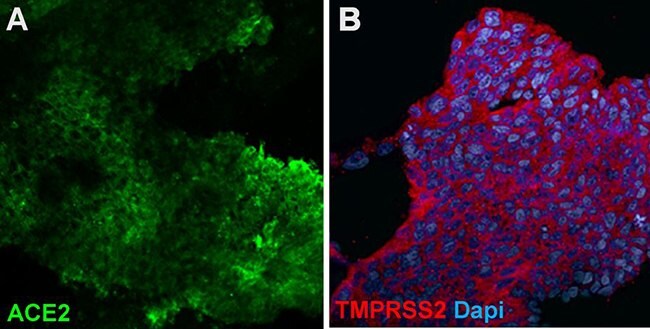
Figure 6. Lung organoids can be used to study SARS-CoV-2 respiratory viral infections. Lung bud organoids express ACE2, the SARS-CoV-2 binding receptor (A) and the serine protease, TMPRSS2 (B), that enhances SARS-CoV-2 viral entry.
Airway Epithelial Lung Organoids Troubleshooting Guide
Problem 1: After transferring lung bud organoids (LBOs) at D20-25 to Matrigel® sandwiches, no branching or alveolar structures are observed after two weeks.
- The 3dGRO™ Lung Organoid Branching Medium (SCM307) and 3dGRO™ Lung Organoid Maturation Medium (SCM308) contain components that are temperature and light sensitive. Prepare aliquots based on the experiment planned, and avoid repeated freeze/thaw. It is important to follow the instructions in the “Storage and Stability” section in the manual. Thaw and use a new aliquot of 3dGRO™ Lung Organoid Branching Medium (SCM307) and/or 3dGRO™ Lung Organoid Maturation Medium (SCM308).
- Select LBOs that have folded structures to transfer to make Matrigel® sandwiches. Refer to Figure 3 for examples of LBOs with folded structures.
- High cell density should be observed at both day 4 and day 8 before starting the floating suspension culture; adjust seeding density based on cell type.
Problem 2: Floating LBOs attach to the bottom of the plate during suspension culture.
Use ultra-low attachment 24-well plates rather than tissue culture treated 24-well plates or Petri dishes.
Problem 3: After changing the medium for the Matrigel® sandwiches, the top layer appears soft or collapses.
Add 75 µL of 100% Growth Factor Reduced (GFR) Matrigel® matrix to the top layer of the sandwich instead of 50 µL. Put the 24-well plates in the incubator for ≥30 minutes to ensure that the Matrigel® sandwiches have solidified.
Problem 4: The proportion of c-kit+/CXCR4+ positive cells is below 80% at day 4.
A compact c-kit+/CXCR4+ cell population should be observed at day 4 with positive cells 80-90% or higher. It is not recommended to continue the differentiation without successful definitive endoderm induction at day 4. Restart using high quality, undifferentiated human iPS cell cultures.
Problem 5: During the later stages of maturation, the medium may turn yellow quickly.
During this time, the embedded organoids may enlarge and some may extend complex processes (Figure 5). Add 750 µL of 3dGRO™ Lung Organoid Maturation Medium (SCM308) to the top of the inserts and 500 µL into the wells underneath the inserts.
Products
如要继续阅读,请登录或创建帐户。
暂无帐户?